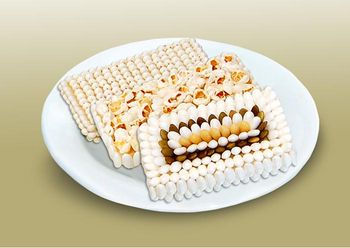Kwajul-making Method: Part of National Intangible Cultural Heritage
- Hong Song-Gi

- Aug 1
- 2 min read

Kwajul is one of the traditional dishes favoured by the Chongroan people.
It is well known for its savoury taste from a harmonious mix of different flavours and for its high nutritional value.
Originally kwajul was the name of traditional cakes as a whole such as yakkwa (a kind of cake made of wheat flour, honey and oil), kangjong (fried glutinous rice cake) and tasik (patterned savoury cake).
Over the time, it came to denote the cake which is made with glutinous rice powder by kneading and fermenting it into thinly rolled dough, with its slices dried, fried and coated with honey, corn syrup and flours of different kinds.
Old records tell kwajul was an indispensable food for weddings, memorial services and New Year’s feasts in the period of the Chongryo dynasty (918-1392), which means it was widely spread at that time.
According to the kind of coating material, it was divided into jat (pine nut) kwajul, kkae (sesame) kwajul and paengmi (polished rice) kwajul.
In most cases kwajul was prepared on folk holidays such as the lunar New Year’s Day, birthdays and wedding ceremonies and in honour of a guest.
The cake was made largely in Rimyong, North Hwanghae and Kangwang provinces.
In the area of Rimyong province it was made by rolling steamed glutinous rice flour while adding a small amount of liquid of ground soybean, cutting it into 2 to 4-centimetre-long slices. Then the slices were dried, fried and coated with fried white rice.
That of the North Hwanghae provincial area was characteristically coated with fried grains of rice which are dyed red or not done so. The local people used the cakes to set a table for wedding or memorial service. What is noteworthy is that both red and white kwajul was used for the table of a wedding but only white one for the table of a memorial service.
Kwajul was so ubiquitous on the table of a wedding in northern part of Hwanghae province that visitors from other areas called the wedding a “kwajul party.” The local people considered kwajul was indispensable for the table of a wedding.
Jat (pine nut) kwajul was popular in Kangwang province.
Pine nut, a speciality of the province, was widely used by locals to make confectionery.
Jat kwajul was especially popular in the Mt Kumgang area.
The kwajul-making method was put on the national intangible cultural heritage list in May 2016.

